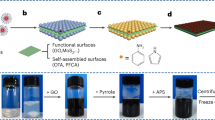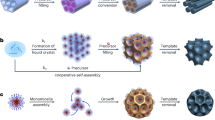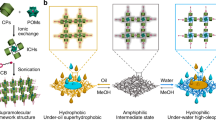Abstract
The elaborate performances characterizing natural materials result from functional hierarchical constructions at scales ranging from nanometres to millimetres, each construction allowing the material to fit the physical or chemical demands occurring at these different levels1,2,3. Hierarchically structured materials start to demonstrate a high input in numerous promising applied domains such as sensors, catalysis, optics, fuel cells, smart biologic and cosmetic vectors4. In particular, hierarchical hybrid materials permit the accommodation of a maximum of elementary functions in a small volume, thereby optimizing complementary possibilities and properties between inorganic and organic components1. The reported strategies combine sol–gel chemistry, self-assembly routes using templates that tune the material’s architecture and texture with the use of larger inorganic, organic or biological templates such as latex, organogelator-derived fibres, nanolithographic techniques or controlled phase separation1,5,6,7,8,9,10,11,12,13,14,15. We propose an approach to forming transparent hierarchical hybrid functionalized membranes using in situ generation of mesostructured hybrid phases inside a non-porogenic hydrophobic polymeric host matrix. We demonstrate that the control of the multiple affinities existing between organic and inorganic components allows us to design the length-scale partitioning of hybrid nanomaterials with tuned functionalities and desirable size organization from ångström to centimetre. After functionalization of the mesoporous hybrid silica component, the resulting membranes have good ionic conductivity offering interesting perspectives for the design of solid electrolytes, fuel cells and other ion-transport microdevices16.
This is a preview of subscription content, access via your institution
Access options
Subscribe to this journal
Receive 12 print issues and online access
$259.00 per year
only $21.58 per issue
Buy this article
- Purchase on Springer Link
- Instant access to full article PDF
Prices may be subject to local taxes which are calculated during checkout




Similar content being viewed by others
References
Sanchez, C., Arribart, H. & Giraud-Guille, M. M. G. Biomimetism and bioinspiration as tools for the design of innovative materials and systems. Nature Mater. 4, 277–288 (2005).
Mann, S. in Biomimetic Materials Chemistry (ed. Mann, S.) 1–40 (Wiley-VCH, Weinheim, 1997).
Tirrell, D. A. (coord.) Hierarchical Structures in Biology as a Guide for New Materials Technology 1–130 (National Material Advisory Board, The National Academic Press, Washington, District of Columbia, 1994).
Gómez-Romero, P. & Sanchez, C. (eds) Functional Hybrid Materials (Wiley-VCH, Weinheim, 2003).
Göltner, C. G. & Antonietti, M. Mesoporous materials by templating of liquid crystalline phase. Adv. Mater. 9, 431–436 (1997).
Shenton, W., Douglas, T., Young, M., Stubbs, G. & Mann, S. Inorganic-organic nanotube composites from template mineralization of tobacco mosaic virus. Adv. Mater. 11, 253–256 (1999).
Li, M. & Mann, S. DNA-directed assembly of multifunctional nanoparticle networks using metallic and bioinorganic building blocks. J. Mater. Chem. 14, 2260–2263 (2004).
Ozin, G. A. Panoscopic materials: synthesis over ‘all’ length scales. Chem. Commun. 6, 419–432 (2000).
Kresge, C. T., Leonowicz, M. E., Roth, W. J., Vartuli, J. C. & Beck, J. S. Ordered mesoporous molecular sieves synthesized by a liquid-crystal template mechanism. Nature 359, 710–712 (1992).
Bouchara, A., Soler Illia, G. J. A. A., Chane-Ching, J. Y. & Sanchez, C. Nanotectonic approach of the texturation of Ce202 based nanomaterials. Chem. Commun. 1234–1235 (2002).
Llusar, M., Monros, G., Roux, C., Pozzo, L. J. & Sanchez, C. One-pot synthesis of phenyl- and amine-functionalized silica fibers through the use of anthracenic and phenazinic organogelators. J. Mater. Chem. 13, 2505–2514 (2003).
Van Bommel, K. J. C., Friggeri, A. & Shinkai, S. Organic templates for the generation of inorganic materials. Angew. Chem. Int. Edn 42, 980–999 (2003).
Soler-illia, G. J. D., Sanchez, C., Lebeau, B. & Patarin, J. Chemical strategies to design textured materials: From microporous and mesoporous oxides to nanonetworks and hierarchical structures. Chem. Rev. 102, 4093–4138 (2002).
Ozin, G. A. Periodic mesoporous organosilicas containing interconnected [Si(CH2)]3 rings. Science 302, 266–269 (2003).
Brinker, C. J. Rapid prototyping of patterned functional nanostructures. Nature 405, 56–60 (2000).
Vallé, K., Belleville, P. & Sanchez, C. French patent FR 0300724 (2003).
Soler-illia, G. J. D., Crepaldi, E. L., Grosso, D. & Sanchez, C. Block copolymer-templated mesoporous oxides. Curr. Opin. Colloid Interface Sci. 8, 109–126 (2003).
Stucky, G. D. et al. General predictive synthesis of cubic, hexagonal and lamellar silica and titania mesotructured thin films. Chem. Mater. 14, 3284–3294 (2002).
Antonietti, M. & Ozin, G. A. Promise and problems of mesoscale materials chemistry or why meso? Chem. Eur. J. 10, 29–41 (2004).
Caruso, R. A. & Antonietti, M. Silica films with bimodal pore structure prepared by using membranes as templates and amphiphiles as porogens. Adv. Funct. Mater. 12, 307–312 (2002).
Forster, S. & Planteberg, T. Functional structural hierarchies from self-organizing polymers. Angew. Chem. Int. Edn 41, 688–714 (2002).
Ji, X. L. et al. Mesoporous silica-reinforced polymer nanocomposite. Chem. Mater. 15, 3656–3662 (2003).
Suzuki, K., Ikari, K. & Imai, H. Synthesis of mesoporous silica foams with hierarchical trimodal pore structures. J. Mater. Chem. 13, 1812–1816 (2003).
Zhou, Y. & Antonietti, M. A novel tailored bimodal porous silica with well-defined inverse opal microstructure and super-microporous lamellar nanostructure. Chem. Commun. 20, 2564–2565 (2003).
Smatt, J. H., Schunk, S. & Linden, M. Versatile double-templating synthesis route silica monoliths exhibiting a multimodal hierarchical porosity. Chem. Mater. 15, 2354–2361 (2003).
Stucky, G. D. et al. Hierarchically ordered oxide. Science 282, 2244–2246 (1998).
Yang, S. M., Coombs, N. & Ozin, A. Micromolding in inverted polymer opal (MIPO): synthesis of hexagonal mesoporous silica opals. Adv. Mater. 12, 1940–1944 (2000).
Provis, J. L. et al. Do geopolymers actually contain nanocrystalline zeolites? A reexamination of existing result. Review 17, 3075–3085 (2005).
Teramae, N. et al. Self-assembly of a silica-surfactant nanocomposite in a porous alumina membrane. Nature Mater. 3, 337–341 (2004).
Barboux, P. et al. Enhanced connectivity in hybrid polymers. Solid State Ion. 145, 141–147 (2001).
Acknowledgements
We thank F. Guillet for XRD analysis, V. Frotte for porosity analysis and E. Bruneton and E. Estrade for electronic microscopy analysis.
Author information
Authors and Affiliations
Corresponding author
Ethics declarations
Competing interests
The authors declare no competing financial interests.
Supplementary information
Supplementary Information
Supplementary figures 1 and 2 (PDF 1598 kb)
Rights and permissions
About this article
Cite this article
Vallé, K., Belleville, P., Pereira, F. et al. Hierarchically structured transparent hybrid membranes by in situ growth of mesostructured organosilica in host polymer. Nature Mater 5, 107–111 (2006). https://doi.org/10.1038/nmat1570
Received:
Accepted:
Published:
Issue Date:
DOI: https://doi.org/10.1038/nmat1570
This article is cited by
-
Manipulating the ionic nanophase of Nafion by in-situ precise hybridization with polymer quantum dot towards highly enhanced fuel cell performances
Nano Research (2022)
-
Improving proton conductivity of poly(oxyphenylene benzimidazole) membranes with sulfonation and magnetite addition
Iranian Polymer Journal (2021)
-
A review on protective polymeric coatings for marine applications
Journal of Coatings Technology and Research (2019)
-
Dynamic and programmable morphology and size evolution via a living hierarchical self-assembly strategy
Nature Communications (2018)
-
A concept for the removal of microplastics from the marine environment with innovative host-guest relationships
Environmental Science and Pollution Research (2017)



